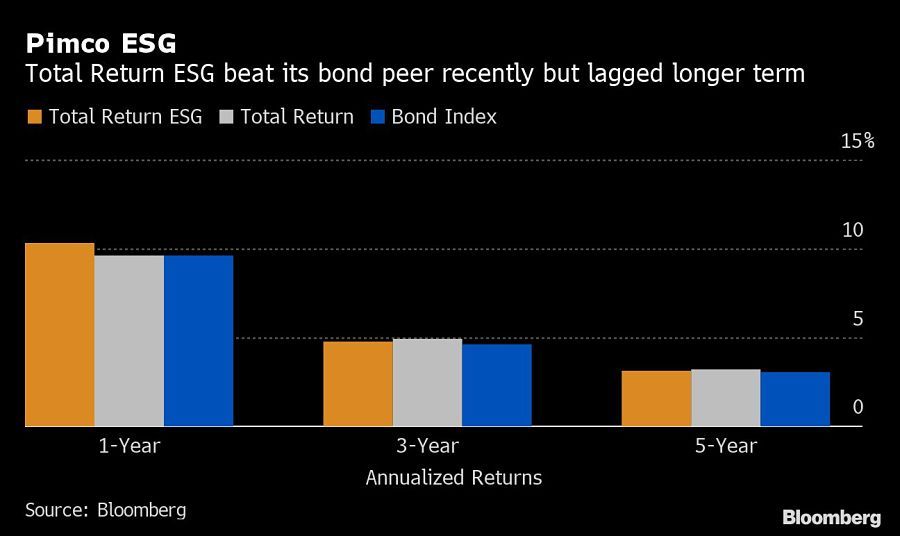Investing in green mutual funds paid off last year as several top funds outperformed those without a sustainable focus. Over a longer period, though, the picture is more mixed.
A Bloomberg analysis of funds that have sustainable equivalents shows there’s neither a long-term edge nor a sacrifice for picking one strategy over the other.
“Most evidence is it’s a wash,” said Jon Hale, head of sustainability research at Morningstar Inc. “There’s no underperformance but there’s no out-performance.”
The results demonstrate the quandary of investing with an environmental, social and governance focus: Is going green good for your portfolio? Below are comparisons of ESG and regular funds offered by Pacific Investment Management Co., Dimensional Fund Advisors and Nuveen.
PIMCO
In the three years since Pimco rebranded its Total Return ESG Fund under Scott Mather, its record has narrowly trailed that of the $68 billion regular Total Return Fund. That reversed in the last 12 months, with the ESG version returning 10.3% through January compared with 9.6% for the original fund.
Both versions track the Bloomberg Barclays U.S. Bond Aggregate Index and share similar macro characteristics reflecting Pimco’s view of factors such as the yield curve and interest rate risk, Mr. Mather said. The ESG version has a bigger allocation to investment-grade credit and almost 30% is in green bonds, compared with less than 2% in the original fund.
While going green was a good bet last year, that could change if opportunities arise for active trading in the oil sector, where the cost of capital — and yields — may rise faster than ESG debt.
“There might be a big snapback,” said Mr. Mather, co-manager of both funds.
NUVEEN

Nuveen’s $5 billion TIAA-CREF Social Choice Equity fund holds fewer than 800 stocks. Its counterpart has almost 3,000. There’s barely a difference in their returns.
In 2019, the Social Choice fund edged out its benchmark, the Russell 3000 Index, and the regular version’s performance net of fees, which are 17 cents per $100 for the institutional class shares compared with 5 cents for the regular fund. Over five years, Social Choice is neck and neck with TIAA’s equity index fund and stacks up favorably to the Russell 3000.
The social fund excludes gambling, weapons, alcohol and tobacco stocks. It also bars companies with outsize carbon footprints, or governance or social concerns. Missing from the portfolio are Facebook Inc., due to data privacy concerns; Berkshire Hathaway Inc., which owns a weapons components maker; General Electric Co.; and Wells Fargo & Co.
To counter those exclusions, the social fund bulks up on other technology and finance names, with a 21% allocation to information technology and 15% to financials.
“The investment objective isn’t to seek alpha,” said Manica Piputbundit, senior director on TIAA’s responsible investing team.
[More: Another major boost for ESG investing ]
DIMENSIONAL FUND ADVISORS

At Dimensional Fund Advisors, two ESG funds holding U.S. and international equities beat their non-ESG peers over one, three and five years.
The records for the Dimensional U.S. Sustainability Core and the International Sustainability Core funds are less consistent when compared with their benchmarks.
Dimensional constructs all of its funds by analyzing securities for company size, value and profitability. For sustainable funds, it adds an overlay that screens mostly for carbon emissions and fossil fuel reserves and also excludes tobacco and munitions producers — without hurting relative performance.

“You have to be able to apply it in a way you don’t sacrifice expected returns,” said Joseph Chi, Dimensional’s head of responsible investment. “We believe the way we’ve done our sustainability core does that.”
In many ways, the funds don’t look that different. The U.S. sustainability fund and its core peer have similar sector allocations, at least when it comes to their largest holdings. Both have more than 21% of their portfolios in information technology and count Apple Inc. as their largest stock.
But they diverge when it comes to energy stocks, which make up 5% of the core fund and less than 2% of the sustainability fund.
Similarly, the international sustainable fund has smaller exposure to energy, while companies such as BP and Royal Dutch Shell are among the top 10 holdings of its non-ESG peer.








